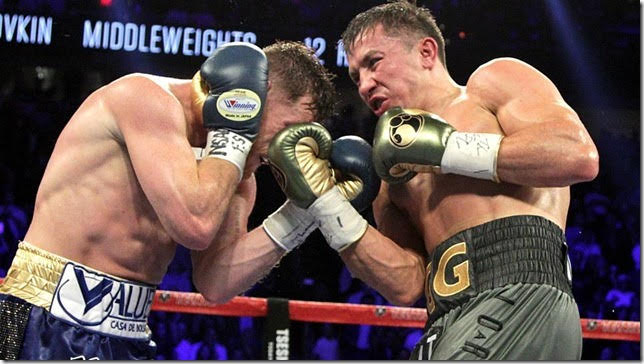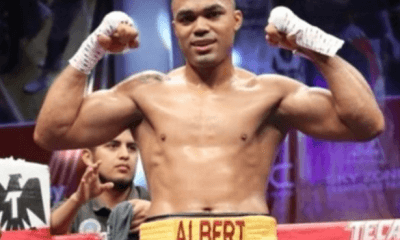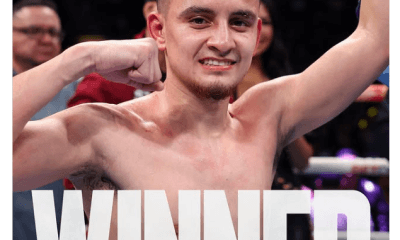Featured Articles
Are You in Favor or Against Open Scoring in Boxing? Results of a TSS Survey
(PART ONE: A-L): It’s time for the Quarterly TSS Survey and this time we asked our panel of noted boxing buffs how they felt about open scoring

(PART ONE: A-L): It’s time for the Quarterly TSS Survey and this time we asked our panel of noted boxing buffs how they felt about open scoring. Specifically, they were asked, “Are you in favor of open scoring whereby the scores of the judges would be revealed after each round or at one or more intervals during the fight? If so, why? If not, why not?” Based on the large number who weighed in, our findings are being published in two parts.
While it was anticipated that most would be against open scoring, there were some interesting inputs that favored it. And some who were against it left no doubt as to their feelings. This will be expanded upon in the Observations Section of Part Two.
The respondents are listed in alphabetical order:
JAMES AMATO–author, writer, collector and historian: I’m not a fan of open scoring. I like the element of surprise at the end of a bout. Who won? Then hearing the decision of the judges. Then followed by shock, disappointment and sometimes sheer rage.
RUSS ANBER–elite cornerman and owner of Rival Sports Equipment: My gut reaction would be to NOT reveal the scores to the fans. Having said that, however, I think in a perfect world the scores could be revealed to the corners. This allows the corners to know the status of their fighter in the heat of the action, yet allows the fans to still watch the fight in a certain amount of excitement, suspense and tradition.
MATT ANDRZEJEWSKI–TSS writer: I used to staunchly oppose any type of open scoring. However, watching the first round of the WBC welterweight tournament earlier this year where scores were revealed one time, halfway through the fight, I began to become more open to the concept. The scores revealed at the halfway point did not take away from any suspense or cause fighters to extremely alter their strategy as we have seen in the past with certain types of open scoring. I think this concept could be beneficial in that cornermen sometimes have a distorted view of how a fight is going but if they hear their fighter is way down may be more apt to pull the plug later on, saving their fighter from unnecessary punishment.
DAVID AVILA—TSS West Coast Bureau Chief: It’s a perplexing question. Open scoring could lead to better scoring by judges. But it could lead to more running by boxers who know they are ahead on the scorecards. I’m leaning toward open scoring because it has not been tried 100 percent.
BOB BENOIT–former pro fighter and current referee: NO I am not in favor of it. Thirty years ago I tried it at a pro show and it took all the ‘mystery’ away. It ruined the show. It sucks. Try it and see. I did.
JOE BRUNO—former New York City sportswriter; prolific author: Bad idea. Then fighters will know when to coast; knowing they are ahead in the scoring. Plus, the mystery that leads to bad decisions makes them more upsetting when they happen. I don’t want to know who’s winning until the fight is over. And if it’s a bad decision, that’s my cue to get pissed.
STEVE CANTON—author, historian, and President of Florida Boxing Hall of Fame: I am not in favor of open scoring and never have been. In fact, in my opinion, most rule changes in boxing in the last several years have had a major negative impact such as day before weigh-ins and going from 15 rounds to 12 in world title fights. I am “Old School” and will remain that way, good or bad. If a fighter knew he was way ahead with a few rounds to go he could conceivably stay away, not take chances and not fight at all knowing he (or she) will win the decision anyway. If a fighter was behind in a fight he might become reckless trying for a knockout and get knocked out himself. What if the fighter who was behind kept boxing and didn’t get reckless and the fighter who was winning either got tired or injured? The outcome of the fight might have been decided because the fighters knew the scorecards rather than by the natural flow of the fight. What if a strong local fight crowd started rioting during the fight when they heard scorecards they didn’t agree with and the fight couldn’t be completed? Leave things alone with our sport and go back to some of things that were changed when our sport was good.
BILL CAPLAN–legendary boxing publicist: I’m in favor of the WBC plan of having open scoring after the 4th and 8th rounds.”
CHARLIE DWYER—former fighter and pro referee: I’m against open scoring simply because it takes away the suspense of waiting for the decision. Also it may cause a boxer to ease up or opt out of a bout once he realizes he’s ahead.
STEVE FARHOOD— Showtime announcer, former editor of The Ring magazine and 2017 IBHOF inductee: I am not, nor have I ever been, in favor of open scoring. I believe it places undue pressure on the judges and eliminates one of the most dramatic moments in boxing–when the ring announcer reads the final scores in a close fight.
BERNARD FERNANDEZ—lifetime member of BWAA and TSS mainstay: Open scoring is something that sounds sort-of feasible to those unfamiliar with boxers and boxing. Communism also sounds sort-of feasible to some people, too. But if history tells us anything, it is that neither concept works. If a world-class fighter believes he has banked enough early rounds to build enough of a lead, he might decide to play keep-away in the “championship” rounds, cheating the fans and possibly himself. (Think Oscar De La Hoya’s failed strategy against Felix Trinidad.) If two fighters have an inadvertent clash of heads in the third or fourth round, and the one who presumably is ahead on the scorecards is leery of the other fighter’s potential to close the gap or score a KO, he might instruct his corner to open the cut wider instead of closing it, in the hope of winning an abbreviated technical decision. Bad decisions will always be a part of boxing, but open scoring can only make things worse.
PEDRO “PETE” FERNANDEZ—former boxer and manager of Ring Talk: You can’t lay the base for a revolution because a close fight is just that. As for posting the scores, I’ve seen guys dog it with that system down the stretch. Just get better judges. I’m an ABC approved judge; if more people sat through a seminar with esteemed Judge Steve Weisfeld, they, the masses, would be in a better position to complain. Posting scores is hokey.
JEFFREY FREEMAN–(aka KO Digest): Open scoring has never worked and it never will. What I’d be more in favor of though is giving the judges a chance to review the fight on tape and to make use of a legitimate, virtual reality-based punch counting device before making their final judgments on who really earned the decision
JERRY FORTE–former Massachusetts Chief Deputy Boxing Commissioner; active amateur and professional judge: NO! We had that system in place here in Massachusetts in the early 90s. We had a red and a blue corner with lights attached. At the end of each round the light would turn on for the fighter that won that particular round. Well, it turned out to be a nightmare If the crowd did not agree with a judge’s decision, they would yell and make threats and in some cases it got physical. Finally the commission ended that way of scoring within a year.
CLARENCE GEORGE–boxing writer and historian: Open scoring adversely affects the quality of fights. If a fighter knows, for instance, that the judges have him ahead, he may very well take his foot off the gas. Two thumbs down (which is my curmudgeonly reaction to most so-called innovations).
LEE GROVES–author, writer and CompuBox wizard: I’m generally not in favor of it because there have been cases where the course of a fight has been changed by that knowledge. Fighters who knew they were so far ahead that they couldn’t lose a decision went into the four-corners defense and fighters who were so far behind have opted to quit in the corner. Such scenarios cheat the audiences that have paid to see the event live, both in the arena and on pay-per-view. I may be portraying old-school thinking, but I’d rather keep the mystery for these reasons.
HENRY HASCUP–historian; President of the New Jersey Boxing Hall of Fame: I was for it once, but I think it would take away from the drama of the fight if we knew what the score was before the end. Another reason is that if fighter A was winning by several points he might coast the rest of the way. Finally, the judges would have more pressure on them as everyone would be looking at their scores and the reaction of the fans might not be too nice!
BRUCE KIELTY–boxing matchmaker, manager, and historian: Open scoring is perhaps the most moronic idea ever advanced by the sanctioning body scumbums. It is similar to showing the end of a movie before the beginning of a movie. If a boxer knows that he is way ahead on points, he simply coasts for three or four rounds to avoid being knocked out. It takes all of the drama out of an event. The answer is hiring quality judges, not incompetent ones or those “on the take.” On the level of stupidity, I would compare this to rules (like in California) where a boxer can be knocked unconscious at 2:51 of the last round and still win the decision
STUART KIRSCHENBAUM—boxing commission emeritus, state of Michigan: I am not in favor of open scoring. The old argument that boxing is the only sport where one does not know the score does not hold any weight. Boxing is the only subjective sport, other than gymnastics and diving to name some, where scores are not earned as runs, baskets, goals, touchdowns and can be objectively calculated. Having been a professional boxing judge, I understand firsthand the pressures and influences this would have on officials and boxers. If an official notes that he is “watching another fight” than the other two judges there might be pressure for him to tighten up his score not to be on the other side of a split decision. In addition, having judged many world championships, there exists the sucking up to promoters and world boxing organization officials to gain their favor to be assigned for expensive trips and lucrative paydays and open scoring would cause further manipulation.
The other negative aspect would occur with the boxers and cornermen. If a boxer knew he was ahead on points he could coast and be virtually non-competitive for as long as needed. The losing boxer, if he knew he was so far behind on points and did not have the ability to knock out his opponent, could either quit or fake a knockdown and this would be considered “throwing a fight”.
As a commissioner, it is our job to weed out bad officials, stop favoritism among officials and understand that professionalism, honesty, integrity of judges would be the most important safeguard to non-open scoring.
JIM LAMPLEY–linchpin of the HBO announcing team; 2009 IBHOF inductee: Opposed. Always have been. Kills suspense for fans, places fighters at risk if they fall behind and take risks not warranted by their abilities, encourages leading fighter to take fewer risks—-and risk is the heart of the sport—-just think it is a bad idea in virtually every way possible.
ARNE LANG–TSS editor-in-chief, author, historian: I’m a traditionalist, so I’m perfectly okay with the current system. If I was watching a fight and to my eyes it was very close, I wouldn’t want to know the scores heading into the final round. The judges might not be seeing it my way and that would spoil it for me — like giving away the “whodunit” before I had the chance to read the last chapter of the mystery novel.
RON LIPTON–world class referee: I have an opinion on this but have to refrain as I am still an active official. (Note: a number of officials responded this way and I included Ron’s as being representative.)
CHECK BACK FOR PART TWO (M-W)
Ted Sares is one of the oldest active power lifters and is the oldest Strongman competitor in the United States. He recently won the Maine State Championship in his class. He is a member of Ring 4 and its Boxing Hall of Fame.
Check out more boxing news on video at The Boxing Channel
-

 Featured Articles4 weeks ago
Featured Articles4 weeks agoResults and Recaps from New York Where Taylor Edged Serrano Once Again
-

 Featured Articles2 weeks ago
Featured Articles2 weeks agoThe Hauser Report: Zayas-Garcia, Pacquiao, Usyk, and the NYSAC
-

 Featured Articles1 week ago
Featured Articles1 week agoOscar Duarte and Regis Prograis Prevail on an Action-Packed Fight Card in Chicago
-

 Featured Articles3 days ago
Featured Articles3 days agoThe Hauser Report: Cinematic and Literary Notes
-

 Featured Articles4 weeks ago
Featured Articles4 weeks agoResults and Recaps from NYC where Hamzah Sheeraz was Spectacular
-

 Featured Articles3 weeks ago
Featured Articles3 weeks agoManny Pacquiao and Mario Barrios Fight to a Draw; Fundora stops Tim Tszyu
-

 Featured Articles4 weeks ago
Featured Articles4 weeks agoPhiladelphia Welterweight Gil Turner, a Phenom, Now Rests in an Unmarked Grave
-

 Featured Articles3 weeks ago
Featured Articles3 weeks agoArne’s Almanac: Pacquiao-Barrios Redux


















